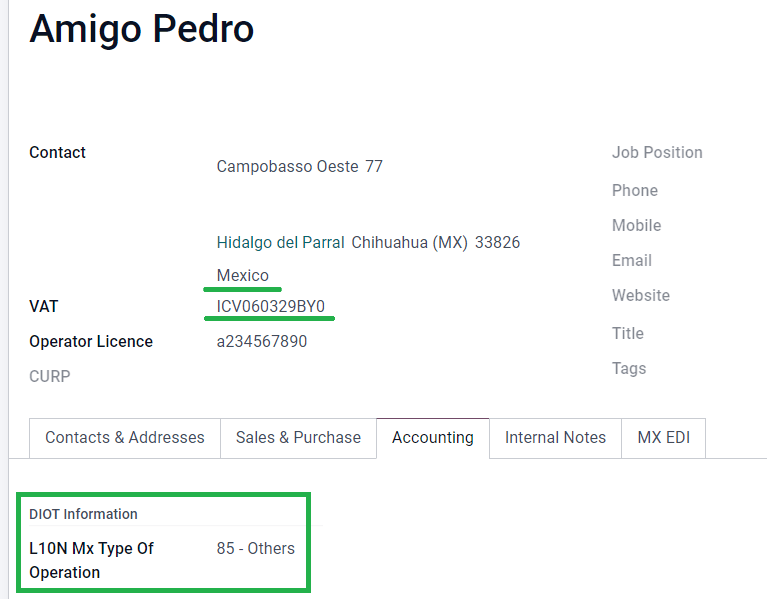Mexique¶
Wébinaires¶
A video on the Mexican localization is also available. This video covers how to implement this localization from scratch, including how to set up the configurations, how to complete common workflows, and provides an in-depth look at several specific use cases, as well.
Introduction¶
The Odoo Mexican localization modules allow for the signing of electronic invoices, according to the specifications of the SAT for version 4.0 of the CFDI, a legal requirement, as of January 1, 2022. These modules also add relevant accounting reports (such as: the DIOT, enables foreign trade, and the creation of delivery guides).
Note
In order to electronically sign any documents in Odoo, ensure the Sign application is installed.
Configuration¶
Prérequis¶
It is necessary to meet the following requirements before configuring the Mexican localization modules in Odoo:
Be registered in the SAT, with a valid RFC.
Have a Certificate of Digital Seal (CSD).
Choisir un PAC (Proveedor Autorizado de Certificación / Prestataire de certification agréé). En ce moment, Odoo travaille avec les PAC suivants : Solución Factible, Quadrum (formerly Finkok) et SW Sapien - Smarter Web.
Have knowledge and experience with billing, sales, and accounting in Odoo. This documentation only contains the necessary information needed to use Odoo.
Installing modules¶
Install the following modules to get all the features of the Mexican localization. The Accounting and Contacts modules are required to be installed for this configuration:
Nom |
Nom technique |
Description |
|---|---|---|
Mexique - Comptabilité |
|
The default fiscal localization package, adds accounting characteristics for the Mexican localization, such as: the most common taxes and the chart of accounts – based on the SAT account grouping code. |
EDI pour la Mexique |
|
Includes all the technical and functional requirements to generate and validate Electronics Documents — based on the technical documentation published by the SAT. This allows you to send invoices (with or without addedums) and payment complements to the government. |
EDI v4.0 pour le Mexique |
|
Nécessaire pour créer des documents XML avec les spécifications correctes du CFDI 4.0. |
Rapports de la localisation mexicaine d’Odoo |
|
Adapts reports for Mexico’s Electronic Accounting: Chart of Accounts, Trial Balance, and DIOT. |
Mexique - Rapports de localisation pour la fermeture |
|
Necessary to create the Closing Entry (Also known as the month 13th move). |
Odoo Mexican XML Polizas Export |
|
Allows the export of XML files of Journal Entries for a compulsory audit. |
Odoo Mexican XML Polizas Export Edi bridge |
|
Complète le module |
Note
When installing a database from scratch and selecting Mexico as the country, Odoo automatically installs the following modules: Mexico - Accounting, EDI for Mexico, and EDI v4.0 for Mexico.
The following modules are optional. It’s recommended to install them only if meeting a specific requirement. Make sure that they are needed for the business.
Nom |
Nom technique |
Description |
|---|---|---|
EDI pour le Mexique (fonctionnalités avancées) |
|
Ajoute le complément du commerce extérieur aux factures : une exigence technique pour vendre des produits à l’étranger. |
EDI v4.0 pour le Mexique (COMEX) |
|
Adapte le module |
Mexique - Guide de livraison électronique |
|
Lets you create a Carta Porte: A bill of lading that proves to the government you are sending goods between A & B with a signed electronic document. |
Guide de livraison électronique pour le Mexique CFDI 4.0 |
|
Adapte le module |
Localisation mexicaine d’Odoo pour Stock/Logistique |
|
Permet de gérer les numéros de douane liés aux coûts logistiques dans les documents électroniques. |
Configurez votre société¶
After installing the correct modules, the next step is to verify that your company is configured with the correct data. To do so, go to , and select Update Info under your company name.
Enter the full Address in the resulting form, including: ZIP code, State, Country, and RFC (VAT number).
According to the requirements of the CFDI 4.0, the name of the main company contact must coincide with your business name registered in the SAT, without the legal entity abbreviation.
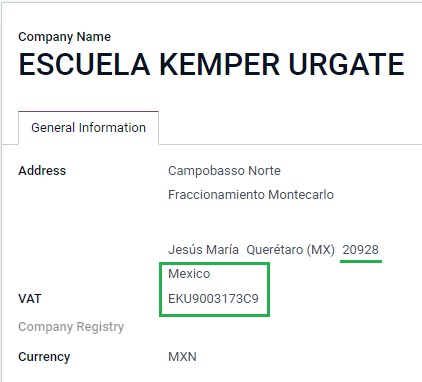
Important
From a legal point of view, a Mexican company must use the local currency (MXN). Therefore, Odoo does not provide features to manage an alternative configuration. If you want to manage another currency, let MXN be the default currency and use a pricelist, instead.
Next, go to , then select the regime that applies to your company from the drop-down list, and click Save.
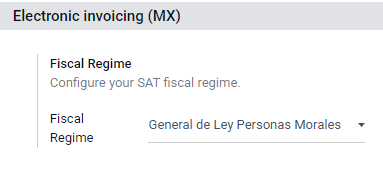
Astuce
If you want to test the Mexican localization, the company can be configured with a real address
within Mexico (including all fields), and add EKU9003173C9 as the VAT and ESCUELA
KEMPER URGATE as the Company Name. For the Fiscal Regime, use
General de Ley Personas Morales.
Contacts¶
To create a contact that can be invoiced, go to . Then, enter the contact name, full Address including: ZIP code, State, Country, and RFC (VAT number).
Important
As with your own company, all of your contacts needs to have their correct business name registered in the SAT. This also applies to the Fiscal Regime, which needs to be added in the MX EDI tab.
Taxes¶
Certaines configurations supplémentaires pour le type de facture et les objets fiscaux doivent être ajoutés aux taxes de vente afin de signer correctement les factures.
Type de facteur¶
The Factor Type field is pre-loaded in the default taxes. If new taxes are created, you need to make sure to configure this field. To do so, go to , then enable the Factor Type field in the Advanced Options tab for all records, with the Tax Type set as Sales.
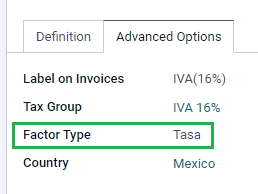
Astuce
Mexico manages two different kinds of 0% VAT to accommodate two scenarios:
0% VAT set the Factor Type as Tasa
VAT Exempt set the Factor Type as Exento
Objet fiscal¶
One requirement of the CFDI 4.0 is that the resulting XML file needs (or does not need) to break down the taxes of the operation. There are three different possible values that are added in the XML file:
01: Not subject to tax - this value is added automatically if your invoice line doesn’t contain any taxes.02: Subject to tax - this is the default configuration of any invoice line that contains taxes.03: Subject to tax and not forced to break down - this value can be triggered on-demand for certain customers to replace the value 02.
To use the 03 value, navigate to , and activate the No Tax Breakdown checkbox.

Important
The No Tax Breakdown value applies only to specific fiscal regimes and/or taxes. Consult your accountant first to see if it is needed for your business before making any modification.
Autres configurations fiscales¶
Lors de l’enregistrement d’un paiement, Odoo effectue le mouvement de taxes du Compte d’attente pour la TVA sur encaissements vers le compte défini dans l’onglet Définition. Pour un tel mouvement, un compte de base de taxe sera utilisé : (Base Imponible de Impuestos en Base a Flujo de Efectivo) dans la pièce comptable lors du reclassement des taxes. Ne supprimez pas ce compte.
If you create a new tax in , you need to add
the correct Tax Grids for it (IVA, ISR or IEPS). Odoo only supports these
three groups of taxes.
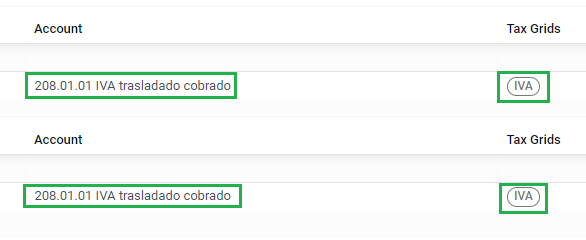
Articles¶
To configure products, go to , then select a product to configure, or Create a new one. In the Accounting tab, and in the UNSPSC Product Category field, select the category that represents the product. The process can be done manually, or through a bulk import.
Note
All products need to have an SAT code associated with them in order to prevent validation errors.
Facturation électronique¶
Identifiants PAC¶
After you have processed your Private Key (CSD) with the SAT, you must register directly with the PAC of your choice before you start creating invoices from Odoo.
Once you’ve created your account with any of these providers, go to . Under the MX PAC section, enter the name of your PAC with your credentials (PAC username and PAC password).
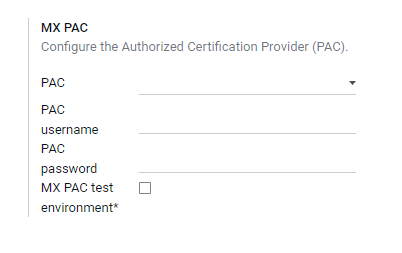
Astuce
If you do not have credentials, but want to test the electronic invoicing, you can activate the MX PAC test environment checkbox, and select Solucion Factible as the PAC. You do not need to add a username or password for a test environment.
Certificats .cer et .key¶
The digital certificates of the company must be uploaded within
the MX Certificates section. To do so, navigate to . Under the MX Certificates section, select
Add a line, and a window will open. Click Create, and from there, upload
your digital Certificate (.cer file), your Certificate Key
(.key file), and your Certificate Password. To finish, click on Save
& Close.
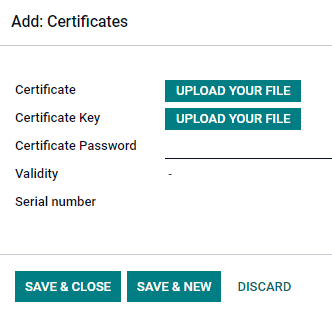
Astuce
If you still do not have one of the contracted PACs and you want to test electronic invoicing, you can use the following SAT test certificates:
Mot de passe :
12345678a
Flux de travail¶
Facturation électronique¶
Le processus de facturation dans Odoo est basé sur l”Annexe 20 version 4.0 de la facturation électronique du SAT.
Factures clients¶
To start invoicing from Odoo, a customer invoice must be created using the standard invoicing flow.
While the document is in draft mode, changes can be made to it (the correct Payment Way or Usage that the customer might require can be added, for example.)
After you Confirm the customer invoice, a blue message appears stating: The invoice will be processed asynchronously by the following E-invoicing service: CFDI (4.0).
Pressing the Process Now button sends the document to the government so it can be signed. After receiving the signed document back from the government, the Fiscal Folio field appears on the document, and the XML file is attached in the chatter.
Astuce
If you click Retry in the SAT status field on the invoice, you can confirm if the XML file is valid in the SAT.
Si vous êtes dans un environnement de test, vous recevrez toujours le message Non trouvé.
To send the signed invoice to your client by mail, you can send both the XML and PDF files together, directly from Odoo, by clicking the Send & Print button. You can also download the PDF file to your computer, by clicking the Print button, and selecting the desired print option.
Avoirs¶
Lorsque la facture est du type « I » (Ingreso), l’avoir est du type « E » (Egreso).
The only addition to the standard flow for credit notes is that, as a requirement of the SAT, there has to be a relation between a credit note and an invoice through the fiscal folio.
Because of this requirement, the field CFDI Origin adds this relation with a 01|,
followed by the fiscal folio of the original invoice.

Astuce
For the CFDI Origin field to be automatically added, use the Add Credit Note button from the invoice, instead of creating it manually.
Compléments de paiement¶
Politique de paiement¶
One addition of the Mexican localization is the Payment Policy field . According to the SAT documentation, there may be 2 types of payments:
PUE(Pago en una Sola Exhibición/Paiement en une seule fois)PPD(Pago en Parcialidades o Diferido/Paiement en versements échelonnés ou différés)
La différence réside dans la Date d’échéance ou les Conditions de paiement de la facture.
To configure PUE invoices, navigatge to , and either select an invoice Due Date within the same month, or choose a payment term that does not imply changing the due month (immediate payment, 15 days, 21 days, all falling within the current month).
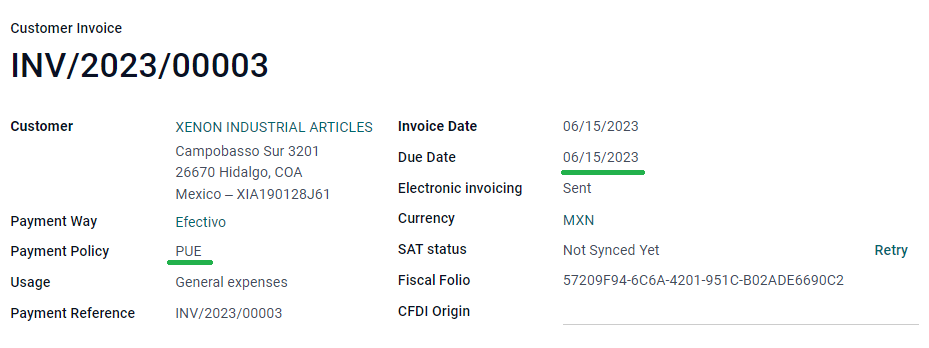
Astuce
Some Payment Terms are already installed by default, and can be managed from .
To configure PPD invoices, navigate to , and select an invoice with a Due Date after the first day of the following month. This also applies if your Payment Term is due in the following month.
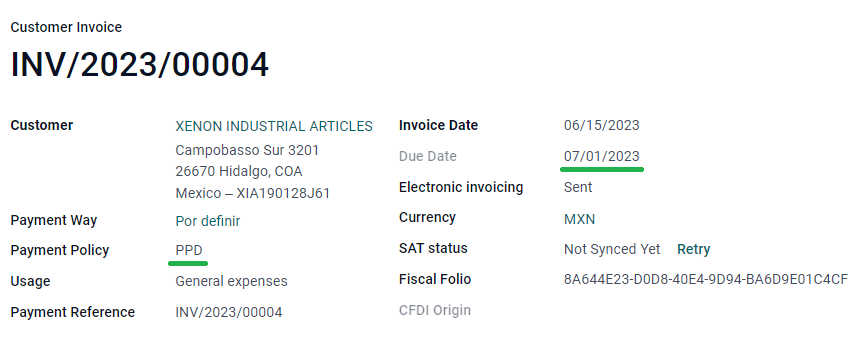
Important
Comme la politique PPD implique qu’une facture ne sera pas payée dans l’immédiat, le Mode de paiement correct pour les factures PPD est 99 - Por Definir (À définir).
Flux de paiement¶
In both cases, the payment process in Odoo is the same, the main difference being payments related to PPD invoices trigger the creation of a document type « P » (Pago).
If a payment is related to a PUE invoice, it can be registered with the wizard, and be associated with the corresponding invoice. To do so, navigate to , and select an invoice. Then, click the Register Payment button. The invoice status changes to In Payment, since the payment is effectively validated when it is bank reconciled.
Pour plus d'infos
While this process is the same for PPD invoices, the addition of the creating an electronic document means some additional requirements are needed to correctly send the document to the SAT.
From an invoice, you need to confirm the specific Payment Way where you received the
payment. Because of this, the Payment Way field cannot be set as 99 - Por Definir
(To Define).
If you are going to add a bank account number in the Accounting tab of a customer’s contact card, it must have a valid account number.
Note
Les configurations exactes figurent dans l”Annexe 20 du SAT. Généralement, le compte bancaire doit comporter 10 ou 18 chiffres pour les transferts et 16 chiffres pour les cartes de crédit ou de débit.
If a payment is related to a signed invoice with the Payment Policy PPD, Odoo
generates the corresponding payment complement automatically, once you click Process
Now.

Avertissement
A payment in MXN cannot be used to pay multiple invoices in USD. Instead, the payment should be separated into multiple payments, using the Register Payment button on the corresponding invoices.
Annulation des factures¶
It is possible to cancel the EDI documents sent to the SAT. According to the Reforma Fiscal 2022, since January 1st, 2022, there are two requirements for this:
With all cancellation requests, you must specify a cancellation reason.
After 24 hours have passed since the creation of the invoice, the client must be asked to accept the cancellation.
Il existe quatre motifs d’annulation différents. Dans Odoo, vous pouvez annuler des factures avec les motifs 01 Factures envoyées avec des erreurs avec une relation et 02 Factures envoyées avec des erreurs sans une relation.
The following sections break down the process of canceling invoices for each cancellation reason in Odoo.
Important
Odoo has certain limitations to canceling invoices in the SAT: The reasons 03 and 04 (Operation did not take place and Nominative transactions related to a global invoice, respectively) are not currently supported by Odoo. For this, you need to cancel the invoice directly in the SAT, and press Retry in the SAT Status field.
01 - factures envoyées avec des erreurs avec une relation¶
This cancellation reason must be used when a new invoice needs to substitute the original one, due to an error in any field.
Begin by navigating to , and select the old
invoice. Copy the Fiscal Folio from the old invoice. Then, navigate to the new invoice,
and in the CFDI Origin field, add the value 04| and paste the Fiscal Folio
of the old invoice after the value. Finally, sign the new document.
Next, navigate back to the old invoice, and notice the Substituted By field is now available. Click the Request EDI Cancellation button on the old invoice, and then click Process Now in the blue section that appears. The invoice status changes to Canceled, and a confirmation is logged in the chatter.
Now, the invoice should be canceled in the SAT as well. You can confirm this was done correctly, by pressing Retry in the SAT status field.
If the document was canceled more than 24 hours after its creation, you may need to ask the client to accept the cancellation in their “Buzón Tributario” directly from the SAT website.
Note
Le 04| est seulement un code qui aide Odoo à effectuer ce processus. Il n’a aucun rapport avec la méthode 04 motif de l’annulation.
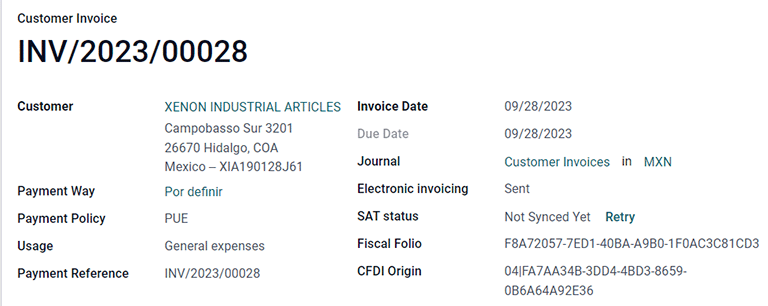
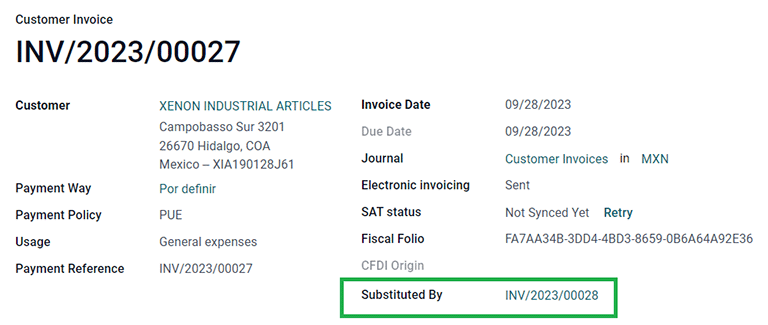
02 - factures envoyées avec des erreurs sans une relation¶
This cancellation reason has to be used when an invoice was sent with an error in any field, and does not need to be replaced by another one.
For this case, navigate to , and select the old invoice. From here, the only requirement is to click the Request EDI Cancellation button, and then click the Process Now button.
Because the field Substituted By does not appear when using this cancellation reason, the SAT should automatically detect that the cancellation reason is 02.
Annulation de paiement¶
It is also possible to cancel Payment Complements. For this, go to the payment, via , and select Request EDI Cancellation. As with invoices, a blue button will appear. Click Process now, and the document will be sent to the SAT. After a few seconds, you can click Retry to confirm the current SAT status.
Finally, the payment status is moved to Cancelled.
Note
Just like invoices, when you create a new Payment Complement, you can add the relation of the
original document, by adding a 04| plus the fiscal folio in the CFDI Origin field.
Cas d’utilisation particuliers de la facturation¶
CFDI au public¶
Si le client auquel vous vendez des biens ou des services ne nécessite pas une facture, un CFDI au public doit être créé.
If you use the Customer name PUBLICO EN GENERAL, an error will be triggered. This is a
main change in the CFDI 4.0 that requires invoices with that specific name to need additional
fields, which Odoo does not currently support. So, for a CFDI to Public to be created, you need to
add any name to your customer that is not PUBLICO EN GENERAL. (For example: CLIENTE FINAL).
In addition to this, it is required that the ZIP code of your company is added, the
generic RFC is set as XAXX010101000, and the Fiscal Regime of your customer must be
set as: Sin obligaciones fiscales.
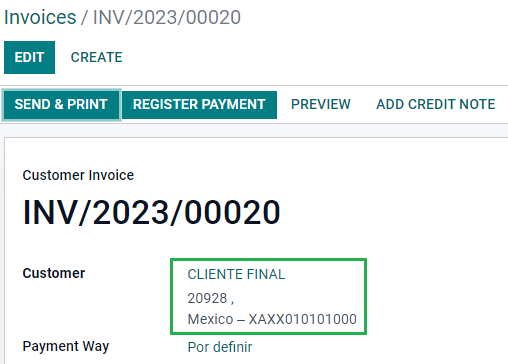
Multi-devise¶
The main currency in Mexico is MXN. While this is mandatory for all Mexican companies, it is possible to send and receive invoices (and payments) in different currencies. To enable the use of multicurrency, navigate to the , and set Mexican Bank as the Service in the Automatic Currency Rates section. Then, set the Interval field to the frequency you wish to update the exchange rates.
This way, the XML file of the document will have the correct exchange rate, and the total amount, in both the foreign currency and in MXN.
It is highly recommended to use a bank account for each currency.
Note
The only currencies that automatically update their exchange rate daily are: USD, EUR, GBP, and JPY.

Acomptes¶
There can be cases where you receive a payment in advance from a customer that needs to be applied to an invoice later. In order to do this in Odoo, it is required to properly link invoices to each other with the CFDI Origin field. To do so, it is necessary to have the Sales app installed.
First, navigate to the app to create a product Anticipo and configure it.
The Product Type must be Service, and use the UNSPSC Category
must be: 84111506 Servicios de facturación.
Then, go to , and add the Anticipo product as the default.
Créez une commande avec le montant total et créez un acompte (un utilisant un pourcentage ou un montant fixe). Puis signez le document et enregistrez le paiement.
When the time comes for the customer to get the final invoice, create it again from the same sales order. In the Create Invoices wizard, select Regular Invoice, and uncheck Deduct down payments.
Then, copy the Fiscal Folio from the first invoice, and paste it into the
CDFI Origin of the second invoice, adding the prefix 07| before the value. Then, sign
the document.
After this, create a credit note for the first invoice. Copy the Fiscal Folio from the
second invoice, and paste it in the CFDI Origin of the credit note, adding the prefix
07|. Then, sign the document.
With this, all electronic documents are linked to each other. The final step is to fully pay the new invoice. At the bottom of the new invoice, you can find the credit note in the Outstanding credits - add it as payment. Finally, register the remaining amount with the Register Payment wizard.
Commerce extérieur¶
The external trade is a complement to a regular invoice that adds certain values in both the XML and PDF, to invoices with a foreign customer according to SAT regulations, such as:
L’adresse précise de l’expéditeur et du destinataire
L’ajout d’une Fraction tarifaire qui identifie le type de produit
The correct Incoterm (International Commercial Terms), among others (certificate of origin and special units of measure).
Cela permet d’identifier correctement les exportateurs et les importateurs, en plus d’élargir la description de la marchandise vendue.
Since January 1, 2018, external trade is a requirement for taxpayers, who carry export operations of type A1. While the current CFDI is 4.0, the external trade is currently on version 1.1
Pour pouvoir utiliser cette fonctionnalité, les modules l10n_mx_edi_extended et l10n_mx_edi_extended_40 doivent être installés.
Important
Before installing, make sure your business needs to use this feature. Consult your accountant first, if needed, before installing any modules.
Configuration¶
Contacts¶
To configure your company contact for external trade, navigate to , and select your Company. While the CFDI 4.0 requirements ask you to add a valid ZIP code in your contact, the external trade complement adds the requirement that your City and the State must also be valid. All three fields must coincide with the Official SAT Catalog, or you will receive an error.
Avertissement
Add the City and State in the company’s contact, not in the company itself. You can find your company’s contact in .
The fields Locality and Colony Code are optional and can be added in the company directly in . These two fields have to coincide with the data in the SAT.
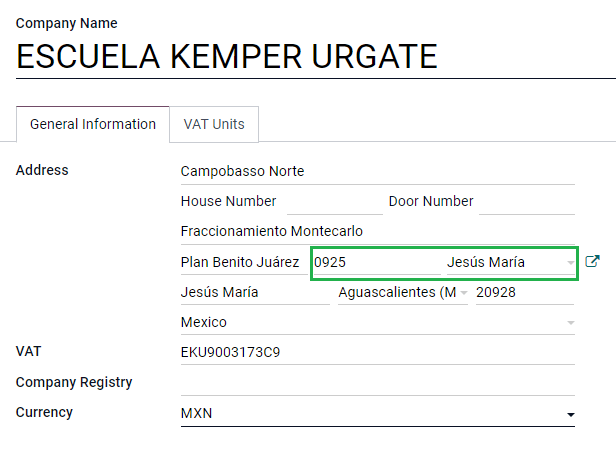
To configure the contact data for a foreign receiving client, navigate to , and select the foreign client’s contact. The contact must have the following fields completed to avoid errors:
L”Adresse complète de la société, y compris un code postal valide et le Pays étranger.
Le format du numéro de TVA étranger (numéro d’identification fiscale, par exemple : Colombie
123456789-1)Dans l’onglet EDI MX, vous devez indiquer si le client reçoit des marchandises pour une période temporaire (Temporaire) ou permanente (Définitif).
Important
If the new contact was created by duplicating another existing contact from Mexico, make sure to delete any carried over information from the Fiscal Regime field. In addition, do not enable the No Tax Breakdown option. Selecting this option hides mandatory fields that are required for external trade contact configuration.
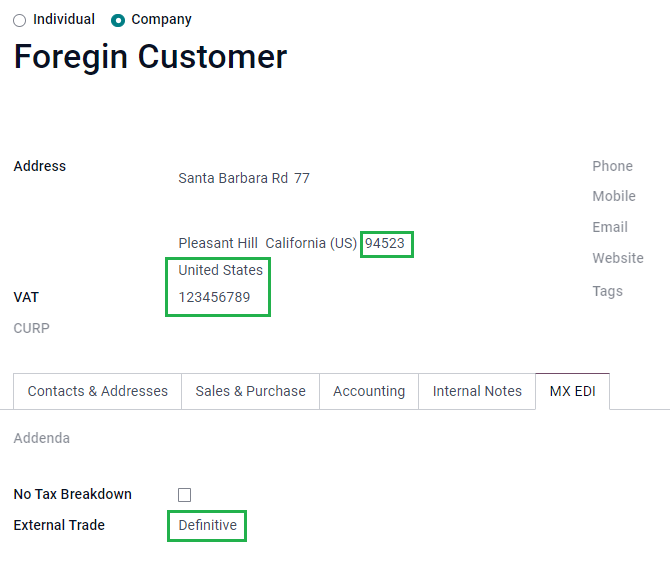
Note
In the resulting XML and PDF files, the VAT is automatically replaced by the generic
VAT for abroad transactions: XEXX010101000.
Articles¶
All products involved with external trade have four fields that are required, two of them exclusive to external trade.
La Référence interne du produit se trouve dans l’onglet Informations générales.
Le Poids du produit doit être supérieur à
0.La bonne Faction tarifaire du produit dans l’onglet Comptabilité.
L”UMT Aduana correspond à la Fraction tarifaire.
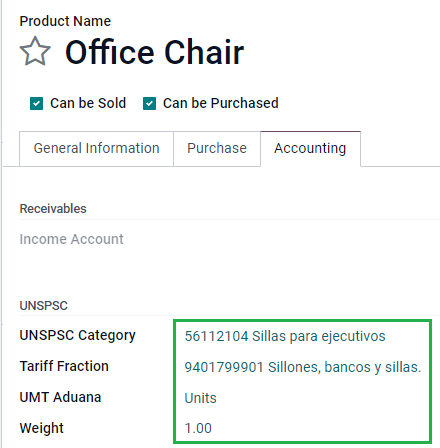
Astuce
Si le code UdM de la Fraction tarifaire est
01, l”UMT Aduana correcte estkg.Si le code UdM de la Fraction tarifaire est
06, l”UMT Aduana correcte estUnités.
Flux de facturation¶
Before creating an invoice, it is important to take into account that external trade invoices require to convert the amounts of your product into USD. Therefore, multicurrency must be enabled and USD must be activated in the Currencies section. The correct Service to run is Mexican Bank.
Then, with the correct exchange rate set up in , the only fields left are Incoterm and the optional Certificate Source in the Other Info tab.
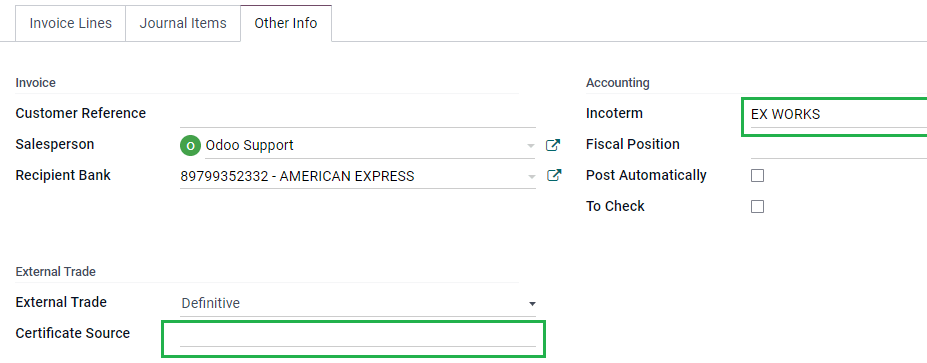
Finally, sign the invoice with the same process as a regular invoice, and click the Process Now button.
Guide de livraison¶
Une Carta Porte est un connaissement : un document qui définit le type, la quantité et la destination des marchandises transportées.
On December 1st, 2021, version 2.0 of this CFDI was implemented for all transportation providers, intermediaries, and owners of goods. Odoo is able to generate a document type « T » (Traslado), which, unlike other documents, is created in a delivery order instead of an invoice or payment.
Odoo can create XML and PDF files with (or without) ground transport, and can process materials that are treated as Dangerous Hazards.
Pour pouvoir utiliser cette fonctionnalité, les modules l10n_mx_edi_extended, l10n_mx_edi_extended_40, l10n_mx_edi_stock et l10n_mx_edi_stock_40 doivent être installés.
In addition to this, it is necessary to have the Inventory and Sales apps installed, as well.
Important
Odoo does not support Carta Porte type document type « I » (Ingreso), air, or marine transport. Consult your accountant first if this feature is needed before doing any modifications.
Configuration¶
Odoo gère deux différents types de CFDI :
No Federal Highways: Is used when the Distance to Destination is less than 30 KM.
Federal Transport: Is used when the Distance to Destination exceeds 30 KM.
Other than the standard requirements of regular invoicing (The RFC of the customer, the UNSPSC code, etc.), if you are using No Federal Highways, no external configuration is needed.
En ce qui concerne le Transfert fédéral, plusieurs configurations doivent être ajoutées aux contacts, aux configurations de véhicules et aux produits. Ces configurations sont ajoutées aux fichiers XML et PDF.
Contacts et véhicules¶
Like the external trade feature, the Address in both the company and the final customer
must be complete. The ZIP code, City, and State must coincide
with the Official SAT Catalog for Carta Porte <sat-catalog_>_.
Astuce
The field, Locality, is optional for both addresses.
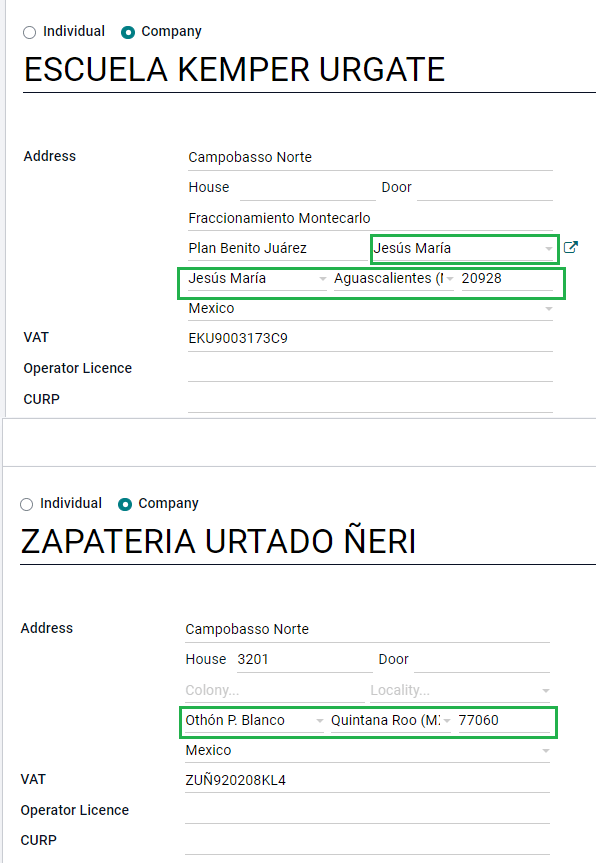
Important
L’adresse originale utilisée pour le guide de livraison est définie dans . Bien qu’il s’agisse par défaut de l’adresse de la société par défaut, vous pouvez la modifier en fonction de l’adresse correcte de votre entrepôt.
Un autre ajout à cette fonctionnalité est le menu de Configuration des véhicules trouvé dans . Ce menu vous permet d’ajouter toutes les informations relatives au véhicule utilisé pour le bon de livraison.
Tous les champs sont obligatoires pour créer un guide de livraison correct.
Astuce
The fields, Vehicle Plate Number and Number Plate, must contain between 5 to 7 characters.
In the Intermediaries section, you must add the operator of the vehicle. The only mandatory fields for this contact are the VAT and Operator Licence.
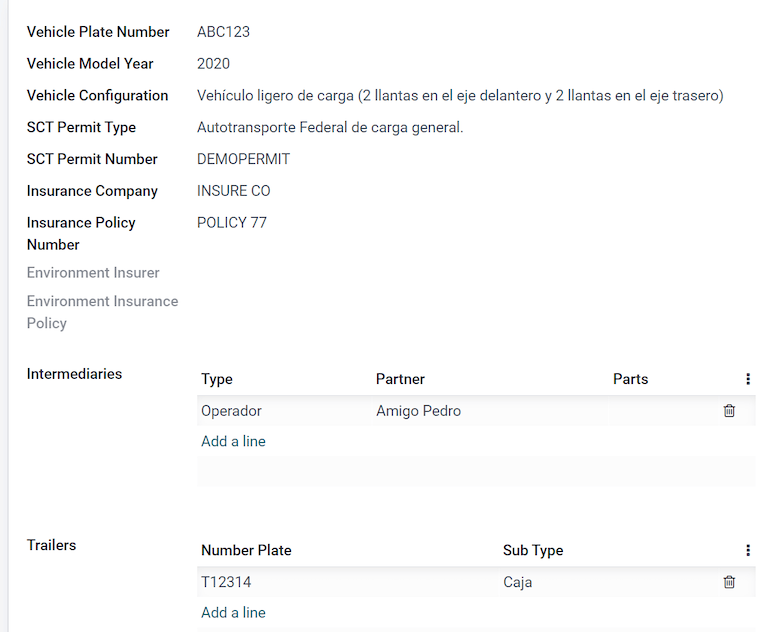
Articles¶
Similar to regular invoicing, all products must have a UNSPSC category. In addition to this, there are two extra configurations for products involved in delivery guides:
Le Type de produit doit être défini sur Produit stockable pour que les mouvements de stock puissent être créés.
In the Inventory tab, the field Weight should have more than
0.
Avertissement
Creating a delivery guide of a product with the value 0 will trigger an error. As the
Weight has been already stored in the delivery order, it is needed to return the
products, and create the delivery order (and delivery guide) again with the correct amounts.
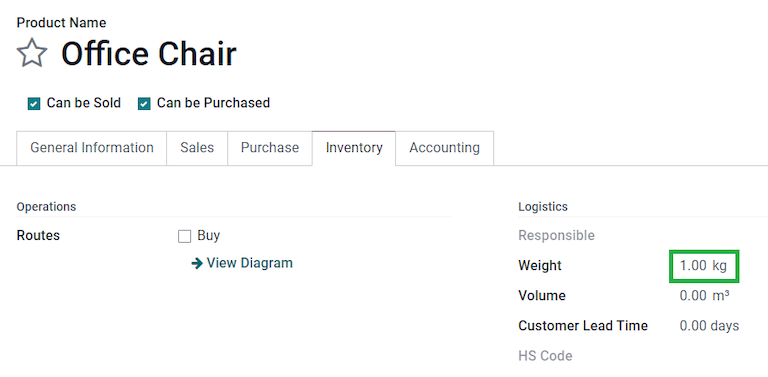
Flux de vente et d’inventaire¶
To create a delivery guide, first, you need to create and confirm a sales order from . This generates a Delivery smart button. Click it, and Validate the transfer.
After the status is set to Done, you can edit the transfer, and select the Transport Type (either No Federal Highways or Federal Transport).
If your delivery guide has the type No Federal Highways, you can save the transfer, and then click Generate Delivery Guide. The resulting XML can be found in the chatter.
Note
Contrairement à l”UNSPSC dans tous les produits, les guides de livraison qui utilisent Pas d’autoroutes fédérales ne nécessitent aucune configuration spéciale pour être envoyés au gouvernement.
If your delivery guide has the type, Federal Transport, the tab MX EDI
appears. There, enter a value in Distance to Destination (KM) bigger than 0, and
select the Vehicle Setup used for this delivery.
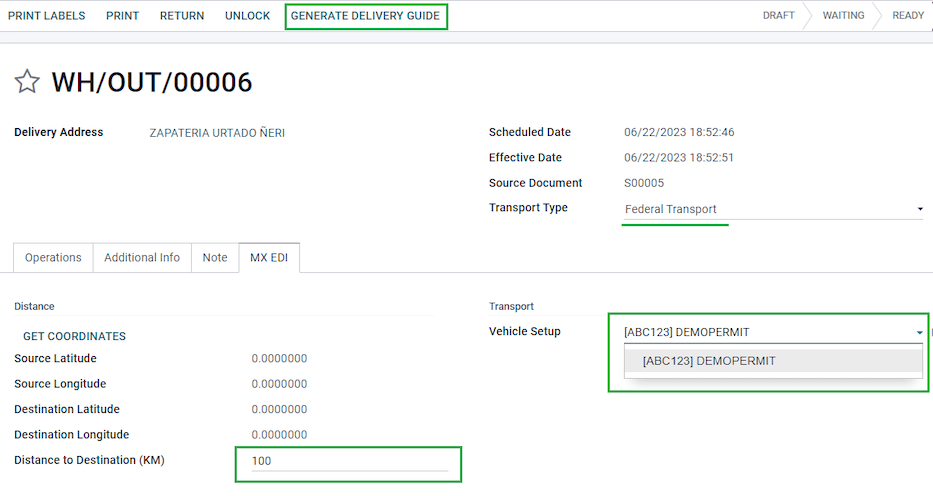
Dangers¶
Certain values in the UNSPSC Category are considered in the official SAT catalog as dangerous hazards. These categories need additional considerations when creating a delivery guide with Federal Transport.
First, select your product from . Then, in the Accounting tab, the fields Hazardous Material Designation Code (MX) and Hazardous Packaging (MX) must be filled with the correct code from the SAT catalog.
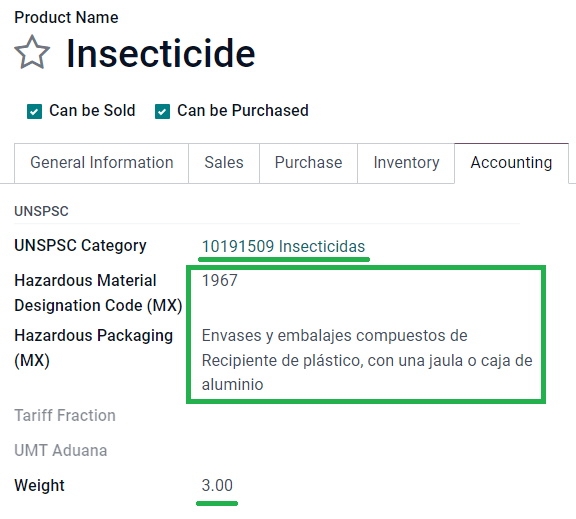
In , the data from the Environment Insurer and Environment Insurance Policy has to be filed, as well. After this, continue with the regular process to create a delivery guide.
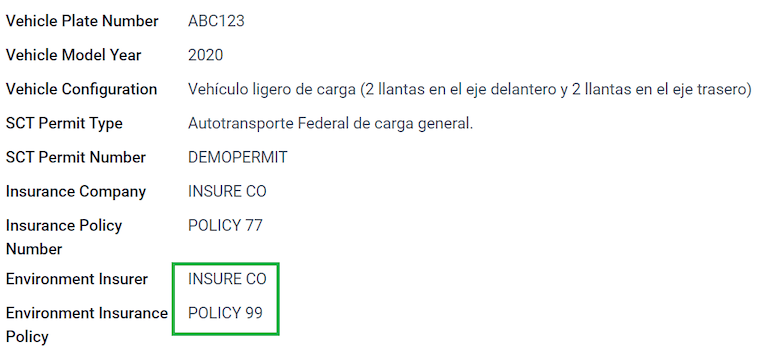
Numéros de douane¶
A customs declaration (Pedimento Aduanero) is a fiscal document that certifies that all contributions to the fiscal entity (the SAT) has been paid for, including the import/export of goods.
According to the Annex 20 of CFDI 4.0, in documents where the invoiced goods come from a first-hand import operation, the field, Customs Number, needs to be added to all lines of products involved with the operation.
To do so, the module l10n_mx_edi_landing must be installed, in addition to the Inventory, Purchase and Sales apps.
Important
Ne pas confondre cette fonctionnalité avec le commerce extérieur. Les numéros de douane sont directement liés à l’importation de biens, tandis que le complément de commerce extérieur est lié à l’exportation. Consultez d’abord votre comptable si vous avez besoin de cette fonctionnalité avant d’effectuer des modifications.
Configuration¶
In order to track the correct customs number for a specific invoice, Odoo uses landed costs. Go to , and make sure that the Landed Costs feature is activated.
Begin by creating a service-type product called, Pedimento. In the Purchase tab,
activate Is a Landed Cost, and select a Default Split Method.
Then, configure the storable products that hold the customs numbers. To do so, create the storable products, and make sure the Product Category has the following configuration.
Méthode de coût : FIFO ou AVCO
Valorisation des stocks : Automatisée
Compte de valorisation des stocks : 115.01.01 Inventario
Journal des stocks : Valorisation des stocks
Compte d’entrée en stock : 115.05.01 Mercancías en tránsito
Compte de sortie de stock : 115.05.01 Mercancías en tránsito
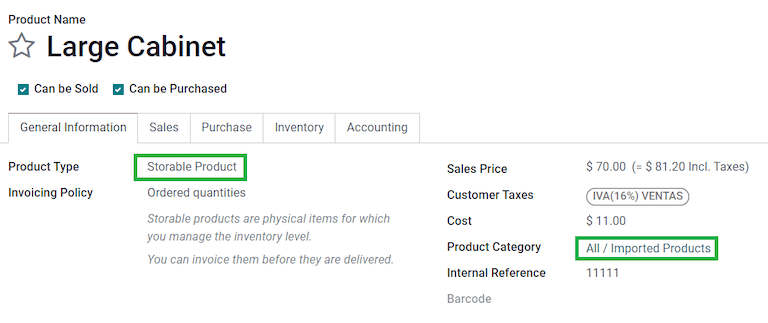
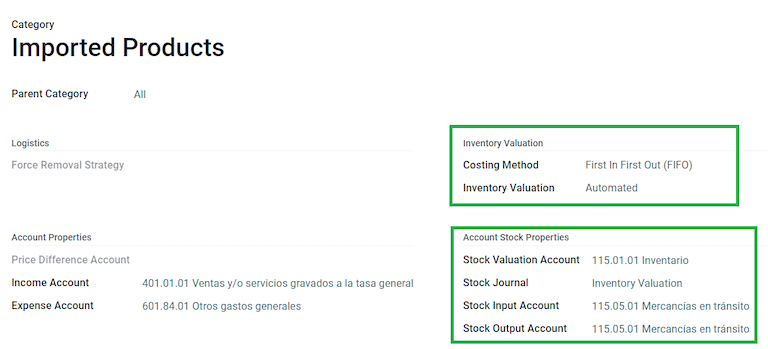
Flux d’achats et de ventes¶
After you configure your product, follow the standard purchase flow.
Create a purchase order from . Then, confirm the order to display a Receipt smart button. Click on the Receipt smart button to Validate the receipt.
Go to , and create a new record. Add the
transfer that you just created, and both: the product Pedimento and Customs number.
En option, vous pouvez également ajouter un montant de coût. Validez ensuite le coût logistique. Une fois enregistré, le numéro de douane est attribué à tous les produits liés à cette réception.
Avertissement
You can only add the Pedimentos number once, so be careful when associating the correct number with the transfer(s).

Now, create a sales order, and confirm it. This should trigger a Delivery smart button. Validate it.
Finally, create an invoice from the sales order, and confirm it. The invoice line related to your product has a customs number in it. This number should match the customs number added in the Landed Costs record you created earlier.
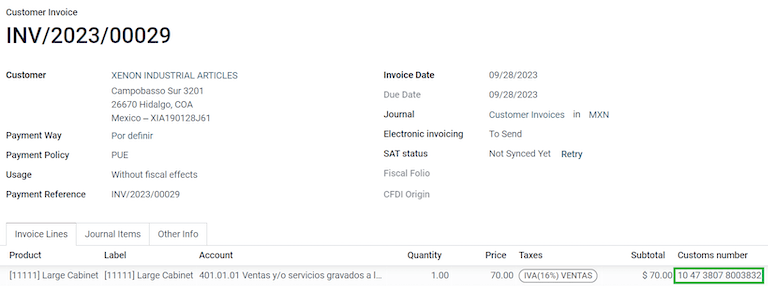
Comptabilité électronique¶
For Mexico, Electronic Accounting refers to the obligation to keep accounting records and entries through electronic means, and to enter accounting information on a monthly basis, through the SAT website.
Elle se compose de trois fichiers XML principaux :
La liste actualisée du plan comptable que vous utilisez actuellement.
A monthly trial balance, plus a closing entry report, also known as: Trial Balance Month 13.
Either optional, or for a compulsory audit, an export of the journal entries in your general ledger.
Les fichiers XML résultants sont conformes aux exigences de l”Anexo Técnico de Contabilidad Electrónica 1.3.
In addition to this, you can generate the DIOT: A report of vendor’s journal entries that involve IVA taxes that can be
exported in a .txt file.
In order to use these reports, the modules l10n_mx_reports, l10n_mx_reports_closing, l10n_mx_xml_polizas and l10n_mx_xml_polizas_edi have to be installed, as well as the Accounting.
You can find the Chart of accounts, Trial Balance Month 13, and DIOT reports in .
Important
Les caractéristiques spécifiques et les obligations des rapports que vous envoyez peuvent changer en fonction de votre régime fiscal. Contactez toujours votre comptable avant d’envoyer quelconque document au gouvernement.
Plan comptable¶
The chart of accounts in México follows a specific pattern based on SAT’s” Código agrupador de cuentas.
You can create any account, as long as it respects SAT’s encoding group: the pattern is
NNN.YY.ZZ or NNN.YY.ZZZ.
Example
Voici quelques exemples : 102.01.99 ou 401.01.001.
When a new account is created in , with the SAT encoding group pattern, the correct grouping code appears in Tags, and your account appears in the COA report.
Once you create all your accounts, make sure the correct Tags are added.
Note
Vous ne pouvez pas utilisez de modèle qui termine une section par un 0 (comme 100.01.01, 301.00.003 ou 604.77.00). Ceci génère des erreurs dans le rapport.
Once everything is set up, you can go to , and click the SAT (XML) button to generate an XML file containing all of your accounts, which will be ready to upload to the SAT website.
Balance générale¶
The trial balance reports the initial balance, credit, and total balance of your accounts, provided that you added their correct encoding group.
This report can be generated monthly, and a corresponding XML file is created, if you go to , and click the SAT (XML) button. Select the month you want to download beforehand.
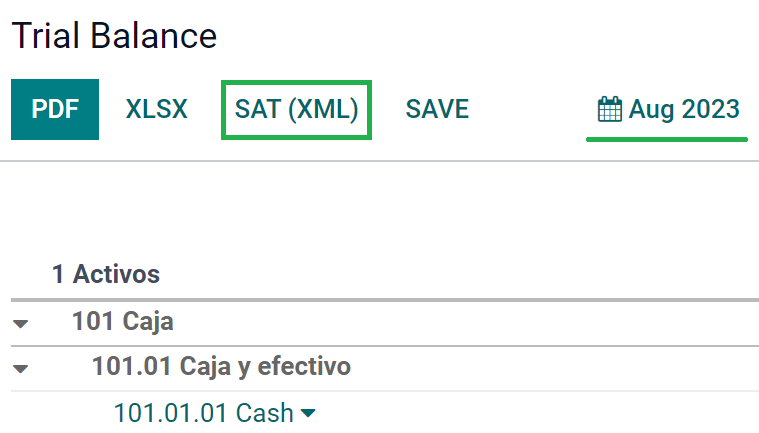
Note
Odoo ne génère pas la Balanza de Comprobación Complementaria.
Un rapport supplémentaire est le 13e mois : un bilan de clôture qui montre tous les ajustements ou mouvements effectués dans la comptabilité pour clôturer l’exercice.
To generate this XML document, navigate to , and create a new document. Here, add all amounts to modify, and balance the debit and/or credit of each one.
After this is done, click Mark as Closing Entry, and the report found in , contains the total amount of the year, plus all the additions of the journal entry.
The XML file is generated by pressing the SAT (XML) button.
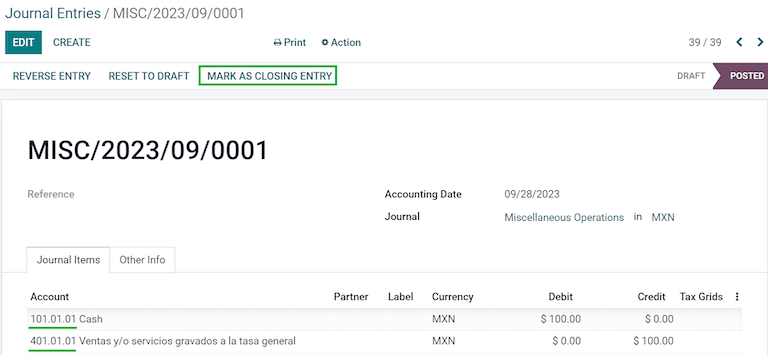
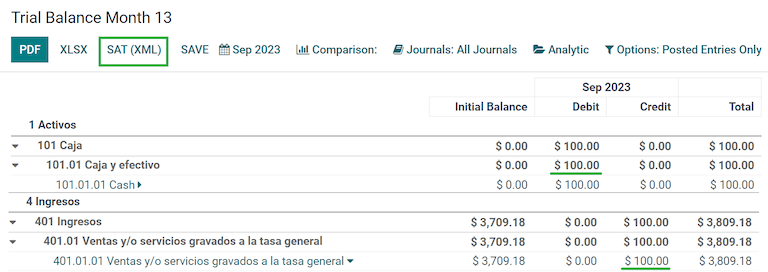
Grand livre¶
By law, all transactions in Mexico must be recorded digitally. Since Odoo automatically creates all the underlying journal entries of your invoicing and payments, you can export your journal entries to comply with SAT’s audits and/or tax refunds.
Astuce
You can filter by period, or by journal, according to your current needs.
To create the XML, go to , and click XML (Polizas). Here, you can select between four types of Export types:
Tax audit
Audit certification
Return of goods
Compensation
For Tax audit, or Audit certification, you need to write the Order Number provided by the SAT. For Return of goods, or Compensation, you need to write your Process Number, also provided by the SAT.
Note
Si vous voulez consulter ce rapport sans l’envoyer, utilisez ABC6987654/99 pour le Numéro d’ordre et AB123451234512 pour le Numéro de traitement.
Rapport DIOT¶
The DIOT (Declaración Informativa de Operaciones con Terceros / Informative Declaration of Operations with Third Parties) is an additional obligation with the SAT, where the current status of creditable and non-creditable payments, withholdings, and refunds of VAT from your vendor bills, are provided to the SAT.
Unlike other reports, the DIOT is uploaded to a software provided by the SAT that contains the
A-29 form. In Odoo, you can download the records of your transactions as a .txt file that
can be uploaded to the form, avoiding direct capture of this data.
The transactions file contains the total amount of your payments registered in vendor bills, broken down into the corresponding types of IVA. The VAT and Country is mandatory for all vendors.
To get the DIOT report, go to . Select the month that suits you, and click DIOT (TXT) to
download the .txt file.
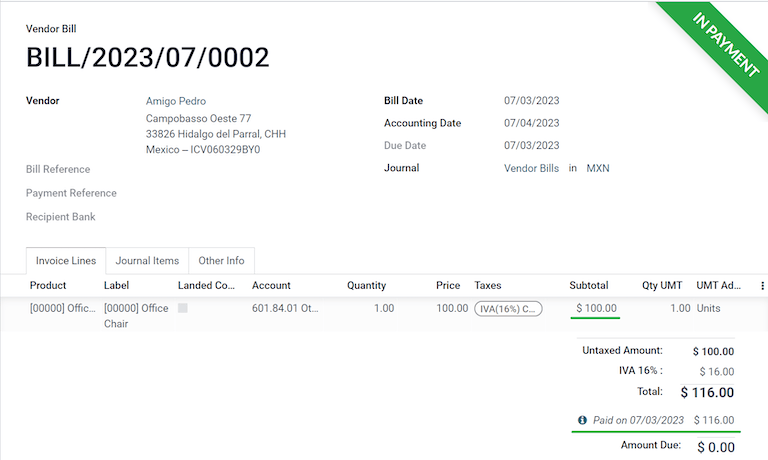

Important
You need to fill the field, L10N Mx Type of Operation, in the Accounting tab of each one of your vendors to prevent validation errors. Make sure that your foreign customers have their country set up for L10N Mx Nationality to appear automatically.
